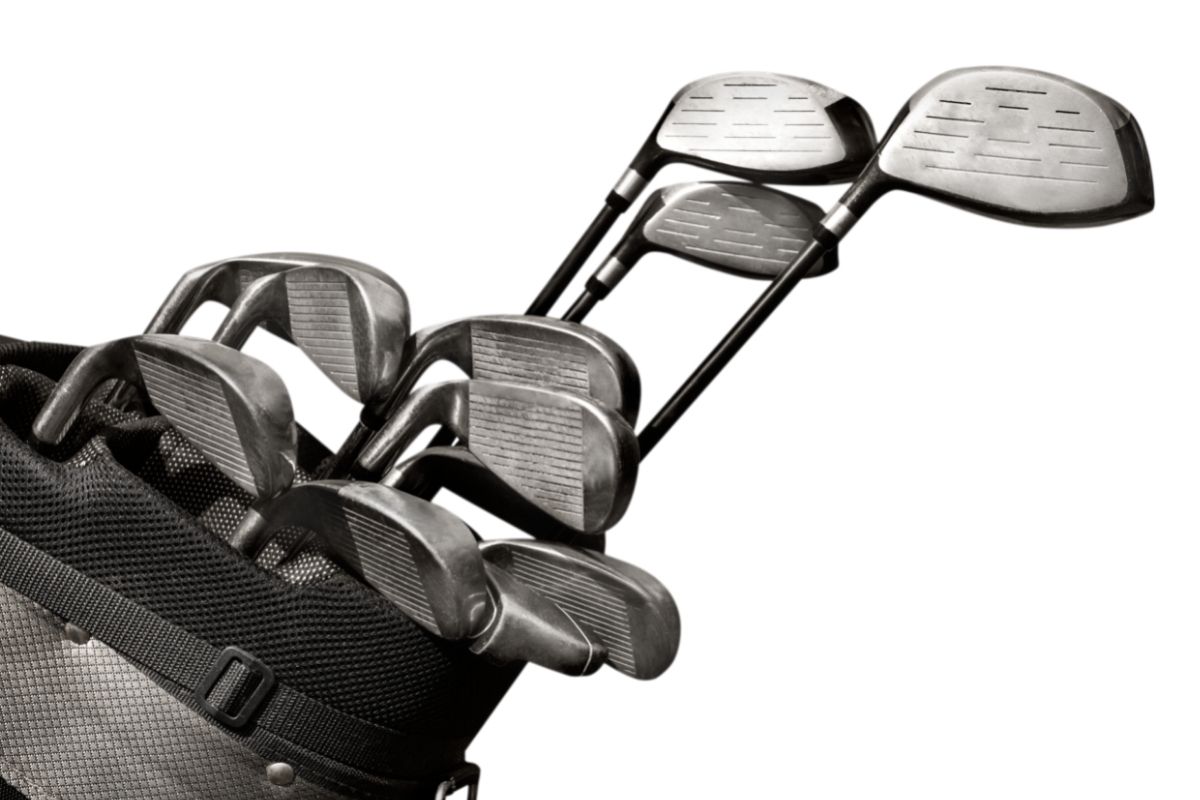We occasionally recommend products we love and might be paid a share of the sale.
Sometimes known as yardage charts, golf distance charts are a handy tool for any golfer hoping to improve their game. They show the average distance that can be hit with each club depending on which skill level is using it.
Golf is a science, composed of angles and power, meaning it’s easy to get lost in all the numbers. Which is why we have compiled all the numbers for you so that you can easily find the information you need.

Below you will find all the distance charts you will need depending on your age, gender, and your skill level. One thing to remember is that all of these charts show averages. As the saying goes, your mileage may vary!
Most good players develop their own distance chart to understand exactly how far each of their own clubs will travel.
Always remember, distance is only one aspect of golf. Plenty of long hitters can’t score well and many shorter hitters still play scratch golf despite their lack of distance.
| Club | Beginner | Average | Good | Excellent | PGA Tour |
| Driver | 190 | 220 | 250 | 280 | 296 |
| 3-wood | 170 | 210 | 225 | 235 | 262 |
| 5-wood | 150 | 195 | 205 | 220 | 248 |
| Hybrid | 145 | 180 | 190 | 210 | 242 |
| 2-iron | 145 | 180 | 190 | 215 | 236 |
| 3-iron | 135 | 170 | 180 | 205 | 228 |
| 4-iron | 125 | 160 | 170 | 195 | 219 |
| 5-iron | 120 | 155 | 165 | 185 | 209 |
| 6-iron | 115 | 145 | 160 | 175 | 197 |
| 7-iron | 105 | 140 | 150 | 165 | 185 |
| 8-iron | 95 | 130 | 140 | 155 | 172 |
| 9-iron | 80 | 115 | 125 | 145 | 159 |
| Pitching Wedge | 70 | 100 | 110 | 135 | 146 |
| Gap Wedge | 60 | 90 | 100 | 125 | 135 |
| Sand Wedge | 55 | 80 | 95 | 115 | 124 |
| Lob Wedge | 40 | 60 | 80 | 105 | 113 |
Here is a rough guide on how to figure out what your skill level is.
- Beginner: Self explanatory, usually people who are within their first few months of playing
- Average golfer: 16-24 handicap
- Good golfer: 8-16 handicap
- Excellent golfer: below 8 handicap
A ‘handicap’ is the number of strokes a player is expected to make over par.
Related article: The Ultimate Guide To Average Golf Handicaps
Beginner Golfers
When starting out golfing it can be a bit overwhelming. New golfers all start with different skills and natural talents or physical traits. For example, junior, women, and senior players may not be able to hit the ball as far as young adult men.
This chart gives you a good idea of the distances a beginning player could be hitting the ball, and it may help you choose what club to use if you aren’t sure.
| Club | Beginner’s Distance (yards) |
| Driver | 190 |
| 3-wood | 170 |
| 5-wood | 150 |
| Hybrid | 145 |
| 2-iron | 145 |
| 3-iron | 135 |
| 4-iron | 125 |
| 5-iron | 120 |
| 6-iron | 115 |
| 7-iron | 105 |
| 8-iron | 95 |
| 9-iron | 80 |
| Pitching Wedge | 70 |
| Gap Wedge | 60 |
| Sand Wedge | 55 |
| Lob Wedge | 40 |
Average Golfers
This chart shows the average distance for male golfers.
| Club | Men’s Average Distance (yards) |
| Driver | 220 |
| 3-wood | 210 |
| 5-wood | 195 |
| Hybrid | 145 |
| 2-iron | 145 |
| 3-iron | 135 |
| 4-iron | 125 |
| 5-iron | 120 |
| 6-iron | 115 |
| 7-iron | 105 |
| 8-iron | 95 |
| 9-iron | 80 |
| Pitching Wedge | 70 |
| Gap Wedge | 60 |
| Sand Wedge | 55 |
| Lob Wedge | 40 |
Female Golfers

Female golfers tend to hit shorter distances than male golfers, but don’t be disheartened by these numbers. It is shown that female golfers are more accurate than their male counterparts.
There are also the Ladies Professional Golf Association (LPGA) tour averages to compare.
| Club | Women’s Average Distance (yards) | LPGA Tour Average (yards) |
| Driver | 200 | 258 |
| 3-wood | 180 | 228 |
| 5-wood | 170 | 216 |
| Hybrid | 170 | 211 |
| 2-iron | 165 | 206 |
| 3 | 160 | 199 |
| 4 | 150 | 190 |
| 5 | 140 | 182 |
| 6 | 130 | 172 |
| 7 | 12 | 161 |
| 8 | 110 | 150 |
| 9 | 100 | 139 |
| Pitching Wedge | 90 | 128 |
| Gap Wedge | 80 | 117 |
| Sand Wedge | 70 | 108 |
| Lob Wedge | 60 | 97 |
Senior Golfers
Golf is inclusive for all ages and there is no point in which you can’t improve. For comparison there are also the Professional Golfers’ Association (PGA) TOUR Champions averages.
| Club | Senior’s Average Distance (yards) | PGA Tour Champions (yards) |
| Driver | 196 | 279 |
| 3-wood | 173 | 240 |
| 5-wood | 164 | 227 |
| Hybrid | 160 | 222 |
| 2-iron | 156 | 217 |
| 3-iron | 151 | 209 |
| 4-iron | 145 | 200 |
| 5-iron | 138 | 191 |
| 6-iron | 130 | 180 |
| 7-iron | 123 | 169 |
| 8-iron | 114 | 157 |
| 9-iron | 105 | 146 |
| Pitching Wedge | 97 | 136 |
| Gap Wedge | 89 | 122 |
| Sand Wedge | 82 | 108 |
| Lob Wedge | 74 | 97 |
Swing Speed
The Trackman system or something similar is a great tool for tracking your swing speed. It is always good to track your speed as that is the main determiner of your distance.
This chart goes up to 150 mph but it is unlikely you will need those numbers. For reference the average swing speed in PGA Tour is around 115 mph.
All these distances are in yards.
| Club | 60 mph | 70 mph | 80 mph | 90 mph | 100 mph | 110 mph | 120 mph | 130 mph | 140 mph | 150 mph |
| Driver (Total) | 155 | 181 | 206 | 232 | 258 | 284 | 310 | 335 | 361 | 385 |
| Driver (Carry) | 146 | 170 | 195 | 219 | 243 | 268 | 292 | 316 | 340 | 365 |
| 3-wood | 130 | 150 | 175 | 195 | 215 | 238 | 259 | 283 | 303 | 318 |
| 5-wood | 125 | 145 | 165 | 185 | 205 | 225 | 245 | 265 | 285 | 305 |
| Hybrid | 120 | 140 | 160 | 180 | 200 | 220 | 240 | 260 | 280 | 300 |
| 2-iron | 118 | 135 | 155 | 176 | 194 | 213 | 233 | 252 | 271 | 292 |
| 3-iron | 115 | 130 | 150 | 170 | 188 | 207 | 226 | 245 | 265 | 284 |
| 4-iron | 110 | 136 | 145 | 165 | 180 | 190 | 208 | 226 | 245 | 264 |
| 5-iron | 105 | 120 | 138 | 155 | 170 | 185 | 198 | 215 | 228 | 247 |
| 6-iron | 100 | 115 | 130 | 145 | 165 | 175 | 185 | 19 | 208 | 219 |
| 7-iron | 95 | 105 | 120 | 135 | 155 | 165 | 175 | 185 | 195 | 210 |
| 8-iron | 85 | 100 | 115 | 130 | 145 | 155 | 165 | 175 | 190 | 202 |
| 9-iron | 80 | 90 | 105 | 120 | 130 | 145 | 160 | 175 | 186 | 197 |
| Pitching Wedge | 73 | 85 | 100 | 110 | 120 | 135 | 145 | 156 | 167 | 179 |
Ball Speed To Distance
This chart can be used to determine different driver ball speeds.
| Ball Speed (mph) | 110 | 120 | 130 | 140 | 150 | 160 | 170 | 180 | 190 | 200 |
| Club Head Speed (Mph) | 77 | 84 | 91 | 98 | 104 | 111 | 118 | 125 | 132 | 138 |
| Driver Carry | 181 | 198 | 241 | 231 | 247 | 263 | 280 | 296 | 313 | 329 |
Driver Swing Speed
As previously stated, swing speed is the main factor in how far your ball goes. The more speed you put into your swing the more power you will gather. If you’re looking to improve your overall game this chart is a good place to start.
| Skill Level | Driver Distance (yards) | Swing Speed (mph) |
| Beginner | 190 | 80 |
| Average | 220 | 94 |
| Good | 240 | 100 |
| Excellent | 265 | 110 |
| PGA Tour Average | 275 | 113 |
| Women’s Average | 180 | 77 |
| LPGA Tour Average | 218 | 94 |
Smash Factor
Smash factor is a relatively new golfing term but it can help immensely once you understand how to utilize it. The way you calculate it is by dividing your ball speed by your club speed.
The higher the smash factory the better the transfer of energy from your golf club. The ideal smash factor is 1.5.
Other Factors To Consider
As well as smash factor the loft of a golf club plays a part in how far you can hit a ball. The more loft a club has the less distance it will go. But what is loft? A loft is the angle created between the club face and the ground.
For comparison a driver will have a loft between 8 and 13 degrees. While a pitching wedge will have a loft from 45 degrees to 47.
You can calculate numbers all day but sometimes there are factors in play that you just can’t control, mainly weather. The optimal weather for a round of golf is a warm wind-less day. On a cold day your ball won’t go as far and wind can be both a benefit and a disadvantage.
While these are all useful tools they are not strict rules to follow. Remember to have fun!
- Funny Golf Terms - February 21, 2023
- How To Play Vegas Golf Game - February 16, 2023
- How To Play Wolf Golf Game - February 16, 2023








